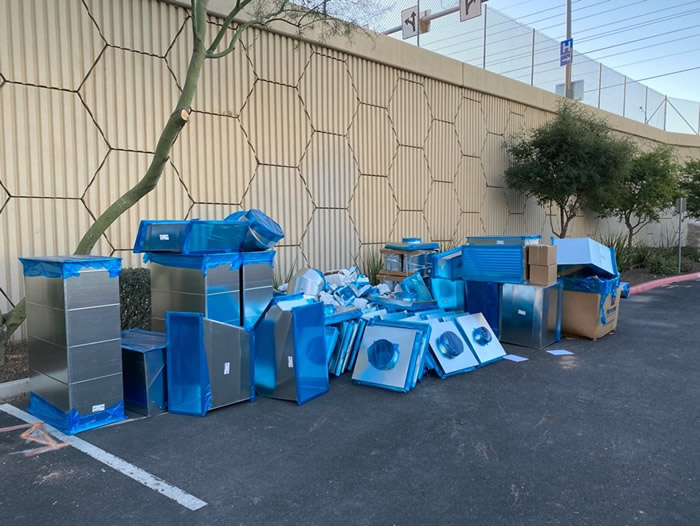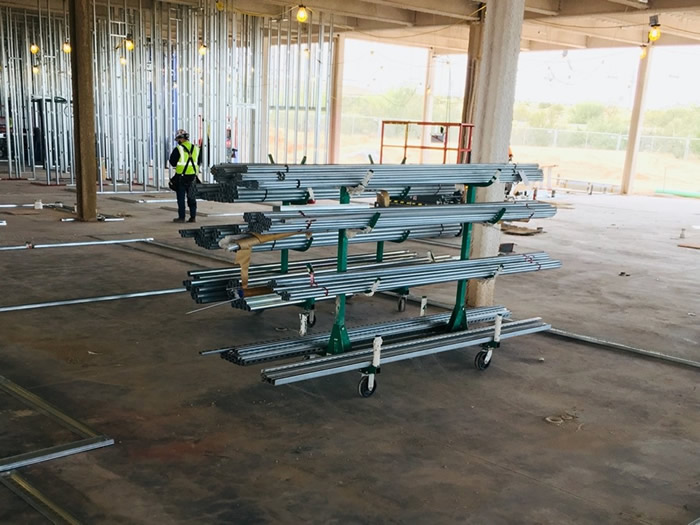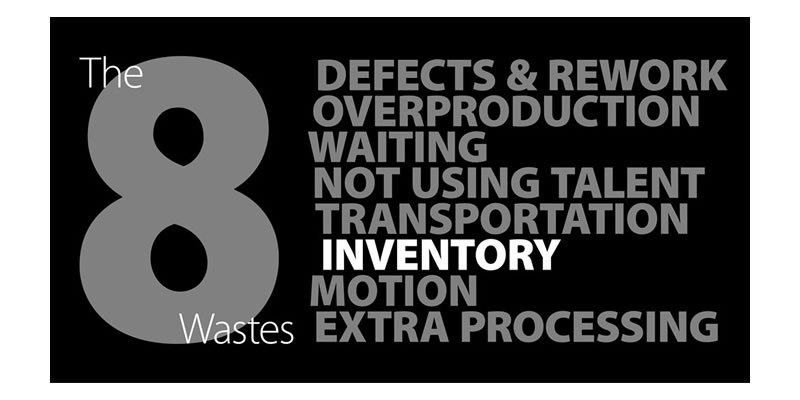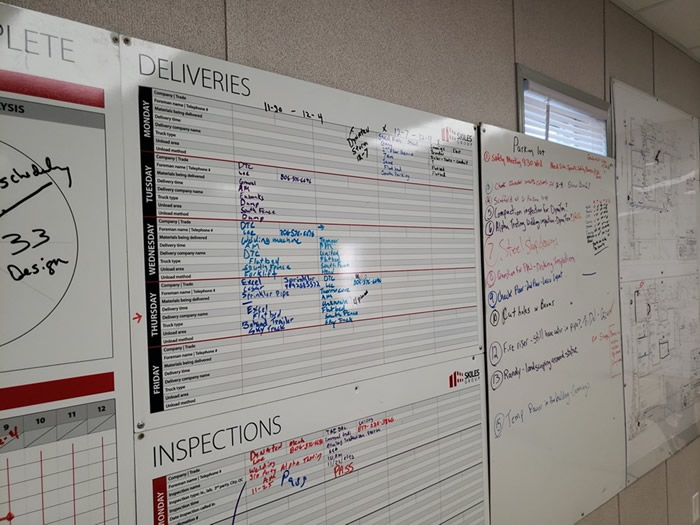Learning about the 8 Wastes of Lean on a jobsite is an important step in your Lean journey, because the first step to overcoming waste that will plague your jobsite is being able to recognize and identify the 8 Wastes of Lean so you can begin the work of eliminating them.
If you are not familiar with the Eight Wastes of Lean, let’s start with the basics. Waste is defined as any task that doesn’t add value. Unfortunately, many of the activities performed on construction projects are non-value added, or waste. There are several acronyms to remember what these wastes are; the one we used in our book, The Lean Builder, is DOWNTIME.
8 Wastes of Lean
DOWNTIME stands for the following wastes:
- Defects
- Overproduction
- Waiting
- Non-Utilized Talent
- Transportation
- Inventory
- Motion
- Excess
To learn more about The Eight Wastes of Lean on the Jobsite click here.
In this post, we are going to discuss the waste called inventory and help you understand how you can be on the lookout to eliminate this waste when it creeps up on your projects—and it will!
In construction, inventory waste occurs when overproduction (another of the eight wastes) results in excess material. Inventory can include materials or products that have not been installed yet and are being stored on the jobsite or in a laydown yard. It can also include extra material, tools, products, or parts that were ordered in excess and brought out to the jobsite. While some inventory may be necessary for installation, it is extremely important to see these excess materials as waste as they will tie up space and resources (for example, inventory will always require additional handling).
What Inventory waste looks like on the jobsite
Inventory waste on a jobsite is easy to see if you are looking for it—and where there is one waste, there is often another. Examples of inventory would include piles of materials, such as pallets of sheetrock, stacks of piping, or bundles of ductwork, sitting on the floor of a project but not ready to be placed. Sure, a certain number of materials need to be onsite for daily installation, but when a drywall trade partner sends all the studs for the entire floor of a building onsite at the same time, knowing install time will span multiple weeks, this is inventory. If you ask any ductwork foreman who’s trying to install ductwork on a floor—but is moving slowly, because there are stacks of studs are everywhere—they will tell you that inventory hampers productivity. Same goes for the drywall foreman who is moving slowly while installing framing, due to all the duct work being delivered to the site at the same time. A material laydown yard may be useful on a jobsite to allow staging for materials to be brought into the building as needed, however the materials in the yard are still inventory. These materials will have to be moved twice (waste) and could be damaged and need repair (waste).

Why the inventory waste is bad for your jobsite
Having inventory may not seem like a bad thing at first but having too much of something on a jobsite can be extremely detrimental to the flow of work. It’s also a lot of money sitting on your job that could “walk away,” if you know what I mean. Inventory waste is one of the worst kind of wastes on a construction site since it leads to many of the other wastes. For example, if the materials get damaged, it will lead to excess processing. When the inventory gets moved to where it needs to be installed, that is transportation. If it’s in the way of other work to be installed, it will lead to waiting. All these wastes add no value and will cost your project time and money. Too much inventory can also be a safety hazard on your project because excess product, tools, or debris can pose a trip hazard. As a Lean builder, you must be looking for waste on your jobsites and the root cause behind why it is happening. Only then can you stop it from occurring.
How to get rid of inventory waste on your jobsite
The best way to reduce inventory waste on your jobsite is to carefully monitor what materials are being brought onto the project and when. By ensuring deliveries are Just-in-Time (a system for producing or delivering the right amount of equipment or materials at the time it is needed for install) you will be able minimize inventory waste because you won’t allow trade partners to over deliver product to your jobsite. Two recommendations for monitoring inventory on your jobsite include:
- A Material Delivery Board
At the daily huddle, foreman can discuss their daily deliveries and document them on a material delivery board, which tracks:
- Who has the delivery?
- What is being delivered?
- When is the delivery scheduled (day and time)?
- What type of truck is it coming in?
- Where is it going to be unloaded?
- How is it going to be unloaded?
- A “Nothing Hits the Floor/Ground” policy
Many progressive construction firms have begun to move to a “nothing hits the floor/ground” policy, meaning, no materials can be resting on the floor and must be on rolling carts and racks, dollies, and pallet jacks. There are many benefits to this type of policy when it comes to safety, but the same can be said when it comes to Lean construction and the eight wastes. Firms that have these policies use the following protocol, which really helps with inventory waste:
- Trade partners have to submit a material/tools/equipment plan prior to the project start and reviewed weekly during construction.
- Materials come onsite on wheels (carts, rocks, dollies, etc). Materials should not be for more than three workdays.
- Designated areas are set up for cutting, and the collected trash from cut materials is cleared daily (if materials are not prefabbed are precut before being brought onsite).
- Weekly huddle to review onsite staging (if needed, with materials needed for less than a week allowed to be staged).
- Material On-Site Stickers that display the date the material was brought in, for accountability.

Try out a material delivery board or a “nothing hits the floor/ground” policy on your project and see what value you gain. Also, here are a few more tips learned over the years to help teams learn to see all of the 8 wastes of Lean:
- Look for it every day – Morning huddles and toolbox discussions are ripe opportunities to teach last planners about inventory waste. Encourage your foremen and “boots on the ground” to come to the daily huddle meeting ready to report on any inventory wastes they have identified and if they were able to resolve it.
- Be accountable for it – As in most cases in the field, visual communication is key. Try making an Eight Wastes board and post in the job trailer or jobsite for yourself and/or your trade partners and field leaders to see on a continuous basis. When items come up, add a person’s name who is responsible for removing or reducing the waste. The more your trades are empowered and held accountable for waste reduction, the more efficient your jobsite will become.
- Eliminate it. Waste can suck the life and morale out of a jobsite culture. It’s disrespectful and will consume valuable resources that would be better utilized in an effective and productive manner. As LCI puts it, “it’s the enemy of good construction.” Make it your personal mission to be relentless against the wastes that you see on your jobsite, even if you’re not the CM/GC. Control what you can control—others WILL recognize it and behaviors WILL
If you have a good tip you would like to share on how to learn to see waste or would like to share an Eight Wastes of Lean story from one of your projects, please let us know in the comments below!










